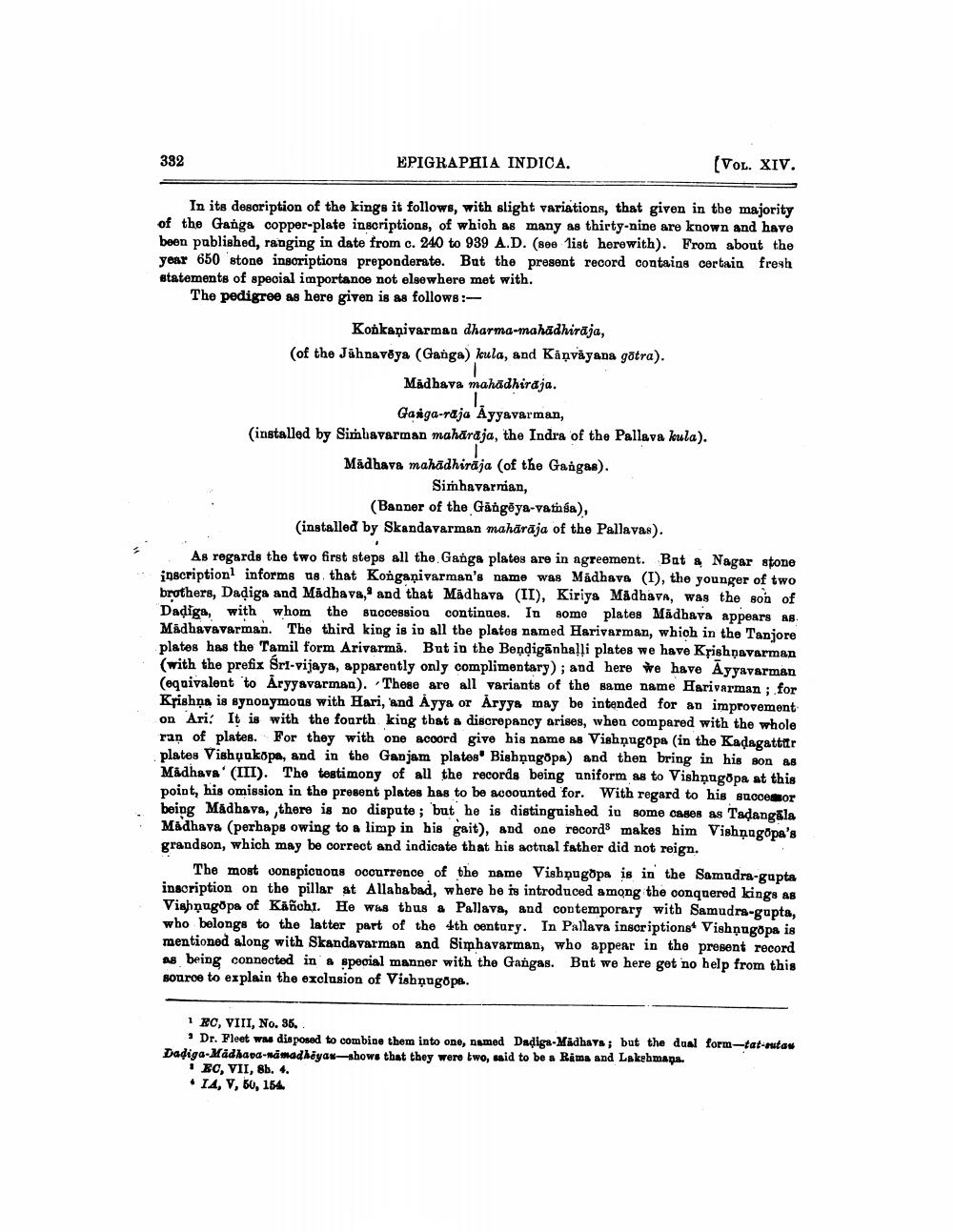________________
332
EPIGRAPHIA INDICA.
(Vol. XIV.
In its description of the kings it follows, with slight variations, that given in the majority of the Ganga copper-plate inscriptions, of which as many as thirty-nine are known and have been published, ranging in date from c. 240 to 939 A.D. (800 list herewith). From about the year 650 stone inscriptions preponderate. But the present record contains certain fresh statements of special importance not elsewhere met with.
The pedigree as here given is as follows:
5
Konkanivarman dharma-mahadhiraja, (of the Jahnavöya (Ganga) kula, and Kaņvāyana götra).
Mädhava mahādhiraja.
Gasiga-raja Ayyavarman, (installed by Simhavarman maharaja, the Indra of the Pallava Kula). Madhava mahadhiraja (of the Gangas).
Simhavarnan,
(Banner of the Gargoya-vatinsa),
(installed by Skandavarman mahārāja of the Pallavas). As regards the two first steps all the Ganga plates are in agreement. Bat & Nagar stone inscription informs us that Kongaộivarman's name was Madhava (I), the younger of two brothers, Dadiga and Madhava,' and that Madhava (II), Kiriya Madhava, was the son of Dadiga, with whom the succession continues. In some plates Madhava appears as Madhavavarman. The third king is in all the plates named Harivarman, which in the Tanjore plates has the Tamil form Arivarma. But in the Bendigānhalli plates we have Krishnavarman (with the prefix Sri-vijays, apparently only complimentary); and here we have Ayyavarman (equivalent to Aryyavarman). These are all variants of the same name Harivarman; for Krishna is synonymous with Hari, and Ayya or Aryys may be intended for an improvement on Ari! It is with the fourth king that a discrepancy arises, when compared with the whole ran of plates. For they with one acord give his name as Vishnugopa (in the Kadagattttr plates Vishụukopa, and in the Ganjam plates Bishạngopa) and then bring in his son as Madhava' (III). The testimony of all the records being uniform as to Vishnugopa at this point, his omission in the present plates has to be accounted for. With regard to his succesor being Madhava, , there is no dispute ; but he is distinguished in some cases as Tadangala Madhava (perhaps owing to a limp in his gait), and one records makes him Vishnugopa's grandson, which may be correct and indicate that his actual father did not reign.
The most conspicuous occurrence of the name Vishnugopa is in the Samudra-gapta inscription on the pillar at Allahabad, where he is introduced among the conquered kings as Vishnugopa of Kanchi. He was thus a Pallava, and contemporary with Samudra-gupta, who belongs to the latter part of the 4th century. In Pallava inscriptions Vishạngopa is mentioned along with Skandavarman and Simhavarman, who appear in the present record as being connected in a special manner with the Gangas. But we here got no help from this source to explain the exclusion of Vishnugopa.
EC, VIII, No. 86.
Dr. Fleet wus disposed to combine them into one, named Dadiga-Madhavs; but the dual form-tat-rutas Dadiga-Madhapa-mamadhayan-shows that they were two, said to be a Rima and Lakemapa.
· EC, VII, 8b. 4. • 14, V, 50, 154.




